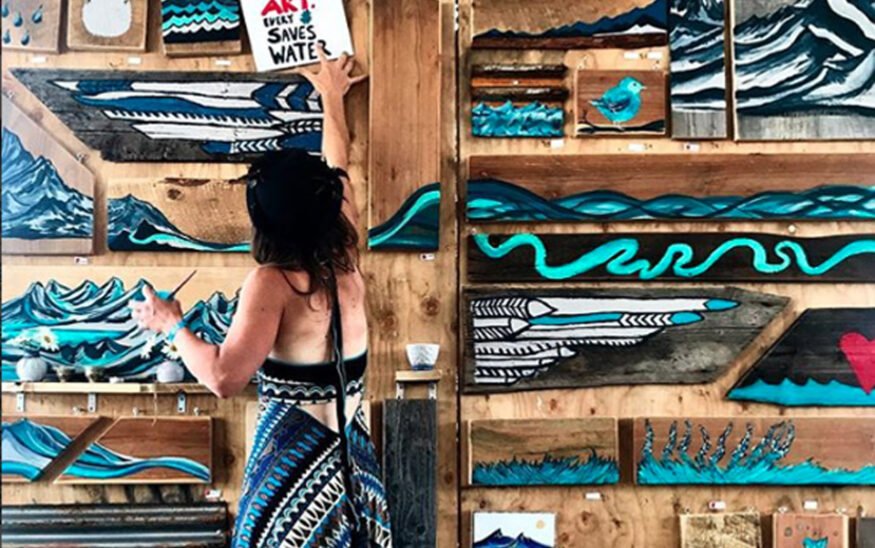Marketing Lessons From Trade School
In tangent with Outdoor Retailer, Trade School's pop-up programming provides usable business lessons and inspiration
Gigi Sukin //January 30, 2018//


Marketing Lessons From Trade School
In tangent with Outdoor Retailer, Trade School's pop-up programming provides usable business lessons and inspiration
Gigi Sukin //January 30, 2018//

PC: JASON DEWITT
Part pop-up art gallery, part-educational lecture series, part-meetup, Trade School, dreamed up by Denver-based Something Independent in partnership with the Denver Theatre District and Colorado Office of Outdoor Recreation Industries, overlapped with Outdoor Retailer Jan. 24 through Jan. 28, with the goal of connecting and inspiring entrepreneurs, athletes, activists and artists around the "nature of work."
"What we're trying to accomplish, whether someone comes in for one session or five days, is to get a real look at real people doing real work that is inherently personal," said Chuck Sullivan, co-founder of Something Independent.
The programming was located at what was called Understudy, an intimate "culture incubator," at the Colorado Convention Center.
"We all have a deep love of the outdoors," said Luis Benitez, director of the Colorado Outdoor Recreation Industry Office. "It's part of what makes us who we are. The outdoor industry is rapidly emerging as an influential voice [in an] important conversation and stewardship, education and workforce development, as well as public health and wellness."
Throughout the five days, panelists included representatives from the Noble Energy, Next 100 Coalition, WeWork, National Ski Patrol, First Descents, Sierra Club, Icelantic, Volunteers for Outdoor Colorado and more.

Friday, Jan. 26 the conversation focused on millennial leadership. There, three panelists – Joe Johnson of Salomon Freeski & Salomon Outdoor, Kalyn Jones of GSI Outdoors and Annie Fedrigo of Hestra Gloves – all who work in marketing for their respective organizations, explored the creativity and resourcefulness millennials bring to business, and in particular, to the outdoor industry. The conversation was moderated by Wheelie Creative.
Here are some of the transferable marketing takeaways and excerpts to keep in your back pocket, whether you're wearing ski pants or suit pants.
BALANCING TRADITION + PROGRESS
"You have to play the game," said Joe Johnson. "I think in my role with Solomon, we're owned by a corporation … and you have to play the game. Sometimes, in the role [outdoor marketing manager], you get stuck doing what's always been done. But there's so much room for creativity."
HOW TO INTRODUCE NEW IDEAS WITHOUT GETTING THE COLD SHOULDER FROM INDUSTRY VETS
"Very slowly for me," said Annie Fedrigo. "I'm slightly relentless about things, even if I get shot down the first time. I try to bring it up a different way the second time. Persistence and also backing up why it might be a good idea."
"Advertising that works in North America is very different from what works in France," Johnson said. "For awhile, I just used what came from the French team when I started. Slowly, we changed the imagery, changed the copy and made it very North American focused. [The higher-ups] were obviously very hesitant to do that, but we showed them examples of what was working in the marketplace."

MILLENNIALS LOVE THEIR CURATED INSTAGRAM FEEDS – HOW TO ADDRESS A YOUNG AUDIENCE
"If you really want to compete, it goes back to creating quality content and being consistent with it," Johnson said.
THE SOCIAL MEDIA MIX
"I've found increased awareness on Twitter," Johnson said. "I see it as an opportunity to be even more conversational. People tweet us and ask, 'Should I get this size boot?'"
"The elephant in the room is Amazon," Jones said. "Having ads on Amazon is smart, and content on Amazon. If you can build out a brand page, your performance goes through the roof."
BUT WHAT ABOUT PRINT?
"We still do quite a bit of print," Fedrigo said. "We're moving over to more digital, but we like to support our partners. Obviously we can't measure that quite as easily as digital, but print has good returns."
"I think digital is where we're committing most of our resources," Johnson said. "At the same time, we feel a duty to support those print products that are still around. Consumers still drop Skiing magazine on the counter saying, 'I want that ski.'"



























